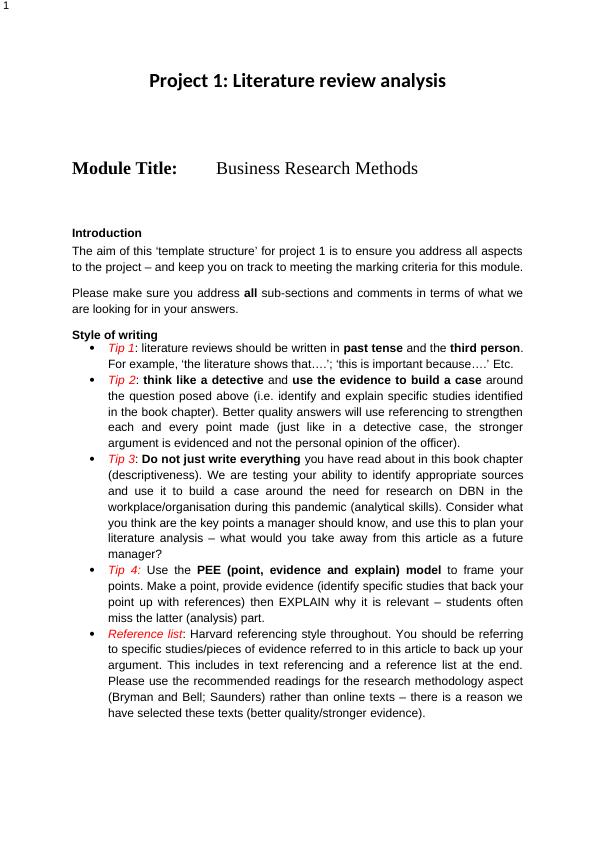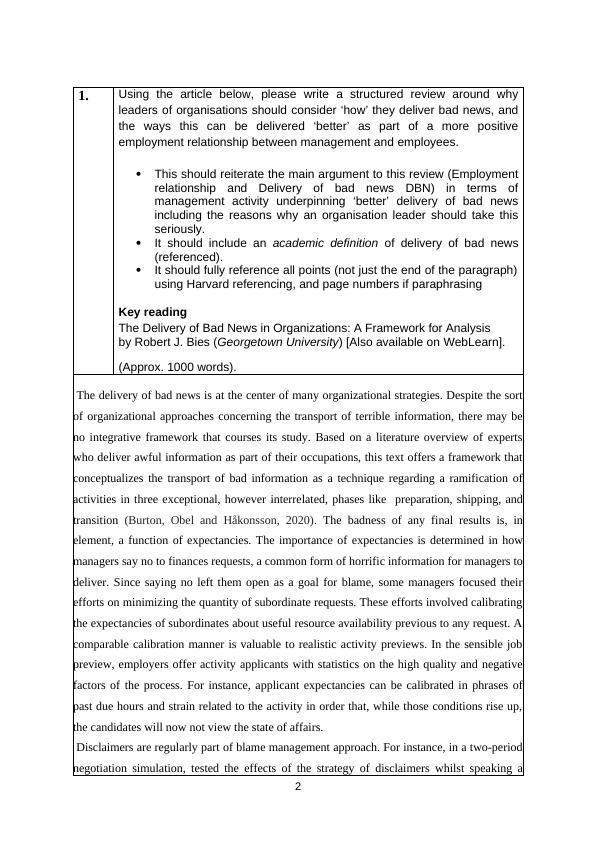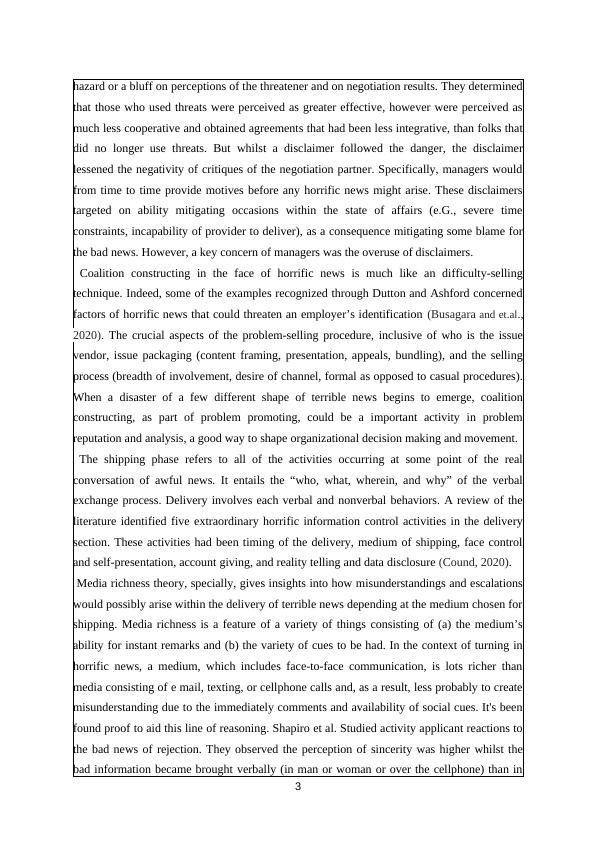Delivering Bad News in Organizations: Importance of Better Delivery for Positive Employment Relationship
9 Pages2870 Words175 Views
Added on 2023-06-14
About This Document
This literature review analyzes the importance of better delivery of bad news for positive employment relationship between management and employees. It includes a structured review of the article 'The Delivery of Bad News in Organizations: A Framework for Analysis' by Robert J. Bies and justifies the use of qualitative methodology for researching the delivery of bad news. The potential access and ethical issues are also discussed.
Delivering Bad News in Organizations: Importance of Better Delivery for Positive Employment Relationship
Added on 2023-06-14
ShareRelated Documents
1
Project 1: Literature review analysis
Module Title: Business Research Methods
Introduction
The aim of this ‘template structure’ for project 1 is to ensure you address all aspects
to the project – and keep you on track to meeting the marking criteria for this module.
Please make sure you address all sub-sections and comments in terms of what we
are looking for in your answers.
Style of writing
Tip 1: literature reviews should be written in past tense and the third person.
For example, ‘the literature shows that....’; ‘this is important because....’ Etc.
Tip 2: think like a detective and use the evidence to build a case around
the question posed above (i.e. identify and explain specific studies identified
in the book chapter). Better quality answers will use referencing to strengthen
each and every point made (just like in a detective case, the stronger
argument is evidenced and not the personal opinion of the officer).
Tip 3: Do not just write everything you have read about in this book chapter
(descriptiveness). We are testing your ability to identify appropriate sources
and use it to build a case around the need for research on DBN in the
workplace/organisation during this pandemic (analytical skills). Consider what
you think are the key points a manager should know, and use this to plan your
literature analysis – what would you take away from this article as a future
manager?
Tip 4: Use the PEE (point, evidence and explain) model to frame your
points. Make a point, provide evidence (identify specific studies that back your
point up with references) then EXPLAIN why it is relevant – students often
miss the latter (analysis) part.
Reference list: Harvard referencing style throughout. You should be referring
to specific studies/pieces of evidence referred to in this article to back up your
argument. This includes in text referencing and a reference list at the end.
Please use the recommended readings for the research methodology aspect
(Bryman and Bell; Saunders) rather than online texts – there is a reason we
have selected these texts (better quality/stronger evidence).
Project 1: Literature review analysis
Module Title: Business Research Methods
Introduction
The aim of this ‘template structure’ for project 1 is to ensure you address all aspects
to the project – and keep you on track to meeting the marking criteria for this module.
Please make sure you address all sub-sections and comments in terms of what we
are looking for in your answers.
Style of writing
Tip 1: literature reviews should be written in past tense and the third person.
For example, ‘the literature shows that....’; ‘this is important because....’ Etc.
Tip 2: think like a detective and use the evidence to build a case around
the question posed above (i.e. identify and explain specific studies identified
in the book chapter). Better quality answers will use referencing to strengthen
each and every point made (just like in a detective case, the stronger
argument is evidenced and not the personal opinion of the officer).
Tip 3: Do not just write everything you have read about in this book chapter
(descriptiveness). We are testing your ability to identify appropriate sources
and use it to build a case around the need for research on DBN in the
workplace/organisation during this pandemic (analytical skills). Consider what
you think are the key points a manager should know, and use this to plan your
literature analysis – what would you take away from this article as a future
manager?
Tip 4: Use the PEE (point, evidence and explain) model to frame your
points. Make a point, provide evidence (identify specific studies that back your
point up with references) then EXPLAIN why it is relevant – students often
miss the latter (analysis) part.
Reference list: Harvard referencing style throughout. You should be referring
to specific studies/pieces of evidence referred to in this article to back up your
argument. This includes in text referencing and a reference list at the end.
Please use the recommended readings for the research methodology aspect
(Bryman and Bell; Saunders) rather than online texts – there is a reason we
have selected these texts (better quality/stronger evidence).

2
1. Using the article below, please write a structured review around why
leaders of organisations should consider ‘how’ they deliver bad news, and
the ways this can be delivered ‘better’ as part of a more positive
employment relationship between management and employees.
This should reiterate the main argument to this review (Employment
relationship and Delivery of bad news DBN) in terms of
management activity underpinning ‘better’ delivery of bad news
including the reasons why an organisation leader should take this
seriously.
It should include an academic definition of delivery of bad news
(referenced).
It should fully reference all points (not just the end of the paragraph)
using Harvard referencing, and page numbers if paraphrasing
Key reading
The Delivery of Bad News in Organizations: A Framework for Analysis
by Robert J. Bies (Georgetown University) [Also available on WebLearn].
(Approx. 1000 words).
The delivery of bad news is at the center of many organizational strategies. Despite the sort
of organizational approaches concerning the transport of terrible information, there may be
no integrative framework that courses its study. Based on a literature overview of experts
who deliver awful information as part of their occupations, this text offers a framework that
conceptualizes the transport of bad information as a technique regarding a ramification of
activities in three exceptional, however interrelated, phases like preparation, shipping, and
transition (Burton, Obel and Håkonsson, 2020). The badness of any final results is, in
element, a function of expectancies. The importance of expectancies is determined in how
managers say no to finances requests, a common form of horrific information for managers to
deliver. Since saying no left them open as a goal for blame, some managers focused their
efforts on minimizing the quantity of subordinate requests. These efforts involved calibrating
the expectancies of subordinates about useful resource availability previous to any request. A
comparable calibration manner is valuable to realistic activity previews. In the sensible job
preview, employers offer activity applicants with statistics on the high quality and negative
factors of the process. For instance, applicant expectancies can be calibrated in phrases of
past due hours and strain related to the activity in order that, while those conditions rise up,
the candidates will now not view the state of affairs.
Disclaimers are regularly part of blame management approach. For instance, in a two-period
negotiation simulation, tested the effects of the strategy of disclaimers whilst speaking a
1. Using the article below, please write a structured review around why
leaders of organisations should consider ‘how’ they deliver bad news, and
the ways this can be delivered ‘better’ as part of a more positive
employment relationship between management and employees.
This should reiterate the main argument to this review (Employment
relationship and Delivery of bad news DBN) in terms of
management activity underpinning ‘better’ delivery of bad news
including the reasons why an organisation leader should take this
seriously.
It should include an academic definition of delivery of bad news
(referenced).
It should fully reference all points (not just the end of the paragraph)
using Harvard referencing, and page numbers if paraphrasing
Key reading
The Delivery of Bad News in Organizations: A Framework for Analysis
by Robert J. Bies (Georgetown University) [Also available on WebLearn].
(Approx. 1000 words).
The delivery of bad news is at the center of many organizational strategies. Despite the sort
of organizational approaches concerning the transport of terrible information, there may be
no integrative framework that courses its study. Based on a literature overview of experts
who deliver awful information as part of their occupations, this text offers a framework that
conceptualizes the transport of bad information as a technique regarding a ramification of
activities in three exceptional, however interrelated, phases like preparation, shipping, and
transition (Burton, Obel and Håkonsson, 2020). The badness of any final results is, in
element, a function of expectancies. The importance of expectancies is determined in how
managers say no to finances requests, a common form of horrific information for managers to
deliver. Since saying no left them open as a goal for blame, some managers focused their
efforts on minimizing the quantity of subordinate requests. These efforts involved calibrating
the expectancies of subordinates about useful resource availability previous to any request. A
comparable calibration manner is valuable to realistic activity previews. In the sensible job
preview, employers offer activity applicants with statistics on the high quality and negative
factors of the process. For instance, applicant expectancies can be calibrated in phrases of
past due hours and strain related to the activity in order that, while those conditions rise up,
the candidates will now not view the state of affairs.
Disclaimers are regularly part of blame management approach. For instance, in a two-period
negotiation simulation, tested the effects of the strategy of disclaimers whilst speaking a

3
hazard or a bluff on perceptions of the threatener and on negotiation results. They determined
that those who used threats were perceived as greater effective, however were perceived as
much less cooperative and obtained agreements that had been less integrative, than folks that
did no longer use threats. But whilst a disclaimer followed the danger, the disclaimer
lessened the negativity of critiques of the negotiation partner. Specifically, managers would
from time to time provide motives before any horrific news might arise. These disclaimers
targeted on ability mitigating occasions within the state of affairs (e.G., severe time
constraints, incapability of provider to deliver), as a consequence mitigating some blame for
the bad news. However, a key concern of managers was the overuse of disclaimers.
Coalition constructing in the face of horrific news is much like an difficulty-selling
technique. Indeed, some of the examples recognized through Dutton and Ashford concerned
factors of horrific news that could threaten an employer’s identification (Busagara and et.al.,
2020). The crucial aspects of the problem-selling procedure, inclusive of who is the issue
vendor, issue packaging (content framing, presentation, appeals, bundling), and the selling
process (breadth of involvement, desire of channel, formal as opposed to casual procedures).
When a disaster of a few different shape of terrible news begins to emerge, coalition
constructing, as part of problem promoting, could be a important activity in problem
reputation and analysis, a good way to shape organizational decision making and movement.
The shipping phase refers to all of the activities occurring at some point of the real
conversation of awful news. It entails the “who, what, wherein, and why” of the verbal
exchange process. Delivery involves each verbal and nonverbal behaviors. A review of the
literature identified five extraordinary horrific information control activities in the delivery
section. These activities had been timing of the delivery, medium of shipping, face control
and self-presentation, account giving, and reality telling and data disclosure (Cound, 2020).
Media richness theory, specially, gives insights into how misunderstandings and escalations
would possibly arise within the delivery of terrible news depending at the medium chosen for
shipping. Media richness is a feature of a variety of things consisting of (a) the medium’s
ability for instant remarks and (b) the variety of cues to be had. In the context of turning in
horrific news, a medium, which includes face-to-face communication, is lots richer than
media consisting of e mail, texting, or cellphone calls and, as a result, less probably to create
misunderstanding due to the immediately comments and availability of social cues. It's been
found proof to aid this line of reasoning. Shapiro et al. Studied activity applicant reactions to
the bad news of rejection. They observed the perception of sincerity was higher whilst the
bad information became brought verbally (in man or woman or over the cellphone) than in
hazard or a bluff on perceptions of the threatener and on negotiation results. They determined
that those who used threats were perceived as greater effective, however were perceived as
much less cooperative and obtained agreements that had been less integrative, than folks that
did no longer use threats. But whilst a disclaimer followed the danger, the disclaimer
lessened the negativity of critiques of the negotiation partner. Specifically, managers would
from time to time provide motives before any horrific news might arise. These disclaimers
targeted on ability mitigating occasions within the state of affairs (e.G., severe time
constraints, incapability of provider to deliver), as a consequence mitigating some blame for
the bad news. However, a key concern of managers was the overuse of disclaimers.
Coalition constructing in the face of horrific news is much like an difficulty-selling
technique. Indeed, some of the examples recognized through Dutton and Ashford concerned
factors of horrific news that could threaten an employer’s identification (Busagara and et.al.,
2020). The crucial aspects of the problem-selling procedure, inclusive of who is the issue
vendor, issue packaging (content framing, presentation, appeals, bundling), and the selling
process (breadth of involvement, desire of channel, formal as opposed to casual procedures).
When a disaster of a few different shape of terrible news begins to emerge, coalition
constructing, as part of problem promoting, could be a important activity in problem
reputation and analysis, a good way to shape organizational decision making and movement.
The shipping phase refers to all of the activities occurring at some point of the real
conversation of awful news. It entails the “who, what, wherein, and why” of the verbal
exchange process. Delivery involves each verbal and nonverbal behaviors. A review of the
literature identified five extraordinary horrific information control activities in the delivery
section. These activities had been timing of the delivery, medium of shipping, face control
and self-presentation, account giving, and reality telling and data disclosure (Cound, 2020).
Media richness theory, specially, gives insights into how misunderstandings and escalations
would possibly arise within the delivery of terrible news depending at the medium chosen for
shipping. Media richness is a feature of a variety of things consisting of (a) the medium’s
ability for instant remarks and (b) the variety of cues to be had. In the context of turning in
horrific news, a medium, which includes face-to-face communication, is lots richer than
media consisting of e mail, texting, or cellphone calls and, as a result, less probably to create
misunderstanding due to the immediately comments and availability of social cues. It's been
found proof to aid this line of reasoning. Shapiro et al. Studied activity applicant reactions to
the bad news of rejection. They observed the perception of sincerity was higher whilst the
bad information became brought verbally (in man or woman or over the cellphone) than in

End of preview
Want to access all the pages? Upload your documents or become a member.
Related Documents
Improving Employment Relationship through Better Delivery of Bad News: A Literature Review Analysislg...
|15
|2967
|478
tips for writing an advance essaylg...
|4
|1588
|25
Assignment on Manufacturing Processlg...
|5
|1361
|472
Health Service Operations Management Assignmentlg...
|4
|640
|388
Grading Guidelines CW1.lg...
|3
|434
|94
Marketing Plan of Healthcare (Doc)lg...
|2
|378
|343
